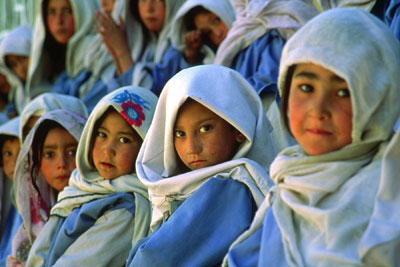Now Is The Taliban Trying To Poison Its SchoolGirls? 300 Hospitalised
Afghan schoolgirls

NEW DELHI: Mysterious fumes in two schools in western Afghanistan have led to more than 300 schoolgirls being hospitalised, as officials suspect that the incidents were deliberate.
115 girls from a school in Herat city were hospitalised after they were poisoned with some type of gas on Thursday, said Herat’s Regional Hospital spokesperson Mohammad Rafiq Sherzai.
Nazia, one of the affected students, told Afghan Pajhwok News: "When I entered the classroom, there was a very strong smell. When I went home, I fell unconscious."
Another student, Atri Gul, said: "When I entered the class my teacher asked us to go out. Then I didn't understand what had happened."
Before that, on Monday, 140 girls were hospitalised from a different school in the city after inhaling a similar gas, Sherzai said. At the same school, another 68 girls fell ill on Wednesday.
Aseeluddin Jami, the deputy governor of Herat province, hinted that he believed that the incidents were deliberate, without providing further details.
Attacks on schoolgirls, however, are common in Herat. In July this year, two men on a motorbike threw acid on three girls as they were on their way to school. "This is the punishment for going to school," the men reportedly told the girls after throwing acid on them, said the hospital head, Jamal Abdul Naser Akhundzada, where the girls were admitted.
These incidents are a reminder that long after the overthrow of the Taliban in 2001, girls in the country are still fighting for the right to an education. Although an estimated 2.5 million girls are officially enrolled in schools, a significantly smaller number actually attend classes regularly. This is because of the impediments faced, with girls in many parts of the country not being allowed to complete a primary education. By the time girls enter secondary school, there is only one girl to every four boys attending in school. Only one in 20 girls attend school beyond the sixth grade. In fact, in about 80 percent of rural districts, there are no girls in secondary school at all.
(2014 saw war-related casualties in Afghanistan reach a record high, with women and children killed also reaching record numbers. Credit: Wikimedia Commons)
This scenario has contributed to an extremely depressing statistic: 85 percent of women in Afghanistan have no formal education and are illiterate.
This, in turn, relates to other equally depressing statistics. More than 50 percent of Afghan girls are married or engaged by age 12. More than 60 percent are married by 16.
In fact, data obtained by the United Nations Assistance Mission in Afghanistan (UNAMA) concludes that the practices that violate the rights of women and girls are pervasive throughout Afghanistan, occurring in all ethnic communities and in rural as well as urban areas.
However, it is important to note that there have been significant improvements in the plight of women in the last decade in Afghanistan. Since 2002, the number of girls attending school increased by over 30 percent; the official age for girls marrying has been increased from to 16 to 17 -- although this means little in practice as most marriages in Afghanistan are without the stamp of a marriage certificate and hence, difficult to monitor; women can be employed (albeit only if their male relatives permit it), child mortality has decreased by half.
(Burqas fail to shield many Afghan women from daily harassment, both in the street and at the workplace. Credit: Shelly Kittleson/IPS)
However, there is a long way to go. The attitude toward women is changing slowly -- as evinced by this recent incident. This lack of change is also represented by the country’s legislation, and even more so by the (lack of) implementation. The landmark Elimination of Violence against Women (EVAW) Law, passed in 2009, remains unevenly enforced and has only led to a limited number of convictions. An Amnesty International investigation found that a lack of political will on the part of Afghan authorities means that government bodies and officials charged with protecting women are under-resourced and lack the support to carry out their work.
Further, women’s rights, or rather -- the lack of, in Afghanistan had come to the international media’s attention recently over the controversy surrounding a bill that would effectively deny women facing abuse legal protection being passed by the Afghan parliament last year.
According to the proposed bill, relatives of the accused could not be questioned as witnesses. As a majority of abuse takes place inside the home most often by family members, the bill implies for instance, that a woman who is the victim of domestic abuse at the hands of her husband cannot testify against him or a girl who has been forced into marriage cannot testify against her family.
(The Afghan Independent Human Rights Commission (AIHRC) estimates a 22 percent increase in cases of violence against women. Marius Arnesen/CC-BY-SA-2.0. Credit: IPS)
The outcry that followed the bill’s signing ensured that the President at the time, Hamid Karzai, did not sign the bill into effect. However, the fact that it was proposed and passed by a majority of the two houses of parliament is indicative of the vulnerable position of women in Afghan society.



